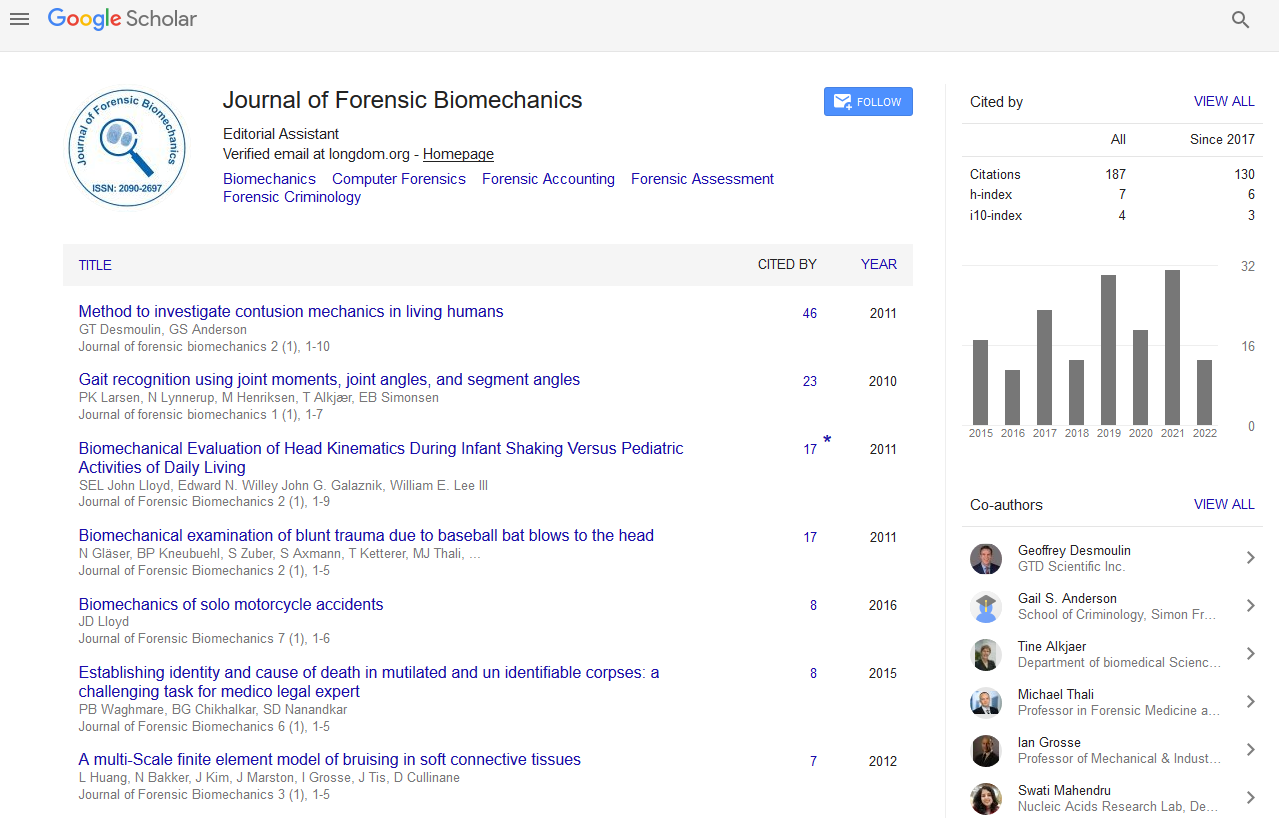Indexed In
- Genamics JournalSeek
- SafetyLit
- Ulrich's Periodicals Directory
- RefSeek
- Hamdard University
- EBSCO A-Z
- Geneva Foundation for Medical Education and Research
- Euro Pub
- Google Scholar
Useful Links
Share This Page
Journal Flyer

Open Access Journals
- Agri and Aquaculture
- Biochemistry
- Bioinformatics & Systems Biology
- Business & Management
- Chemistry
- Clinical Sciences
- Engineering
- Food & Nutrition
- General Science
- Genetics & Molecular Biology
- Immunology & Microbiology
- Medical Sciences
- Neuroscience & Psychology
- Nursing & Health Care
- Pharmaceutical Sciences
Opinion Article - (2024) Volume 15, Issue 3
Forensic Biomechanics Perspectives: Connecting Science and Criminal Justice
Parkinson Zhao*Received: 26-Aug-2024, Manuscript No. JFB-24-27331; Editor assigned: 29-Aug-2024, Pre QC No. JFB-24-27331 (PQ); Reviewed: 12-Sep-2024, QC No. JFB-24-27331; Revised: 19-Sep-2024, Manuscript No. JFB-24-27331 (R); Published: 26-Sep-2024, DOI: 10.35248/2090-2697.24.15.496
Description
Forensic biomechanics is an interdisciplinary field that integrates the principles of biomechanics with the criminal justice system, playing a major role in understanding the mechanics of human movement, injuries, accidents and even criminal acts. By applying scientific methodologies to legal contexts, forensic biomechanics provides objective evidence that can clarify complex cases and assist in the pursuit of justice. This field bridges the gap between science and criminal justice, offering valuable insights into the forces involved in various incidents and their legal implications.
At its core, forensic biomechanics applies the scientific principles of biomechanics the study of how forces affect living organisms to legal scenarios. This involves two primary areas of focus. The first is kinematics, which analyses motion without considering the forces that cause it. Kinematic studies examine the trajectories, velocities and accelerations of individuals during incidents. For example, in a slip-and-fall case, kinematics can help determine how an individual moved before the fall and the dynamics of the fall itself, offering insights into liability and causation. The second area is kinetics, which studies the forces involved in motion. This includes analyzing the magnitude and direction of forces exerted on the body during an event. In motor vehicle accidents, for instance, kinetic analysis can quantify the forces at play, helping to establish whether those forces were sufficient to cause specific injuries. This data is important in legal proceedings, benefiting both plaintiffs and defendants.
Forensic biomechanics serves several essential functions in legal contexts, providing clarity and scientific backing to situations that may otherwise be ambiguous. One of the key applications is accident reconstruction. By analyzing physical evidence and applying biomechanical principles, experts can recreate the events leading up to an injury or accident. This is especially significant in vehicular collision cases, where understanding the dynamics of the crash can shed light on liability. Additionally, forensic biomechanists evaluate the mechanisms of injuries sustained in various incidents. They assess how specific forces affect the body, helping to determine whether the injuries claimed by a plaintiff are consistent with the described events. For instance, if someone claims to have sustained severe injuries from a fall, biomechanics can help determine if the forces involved were adequate to cause those injuries, offering important evidence in court. In cases involving alleged defective products, forensic biomechanics can analyze how the product's design may have contributed to an injury. This may involve examining ergonomic factors, user interaction and the mechanical properties of materials. By establishing a connection between the product and the injury, biomechanists can support claims of negligence or design flaws, influencing the outcome of product liability cases.
The addition of forensic biomechanics into the legal system underscores the importance of scientific evidence in establishing facts and making informed decisions. This union of science and law has several key implications. Forensic biomechanics provides objective, scientific evidence that can support or challenge claims made in court. This is particularly important in cases where subjective accounts and interpretations may introduce biases. By grounding legal arguments in measurable data and established scientific principles, forensic biomechanics enhances the reliability of evidence presented to the court. Forensic biomechanists often serve as expert witnesses in court, helping to interpret complex scientific concepts for judges and juries. Their testimony can clarify intricate details of an incident, making it easier for legal professionals to understand the mechanics behind injuries or accidents.
Citation: Zhao P (2024). Forensic Biomechanics Perspectives: Connecting Science and Criminal Justice. J Forensic Biomech. 15:496.
Copyright: © 2024 Zhao P. This is an open-access article distributed under the terms of the Creative Commons Attribution License, which permits unrestricted use, distribution, and reproduction in any medium, provided the original author and source are credited.

